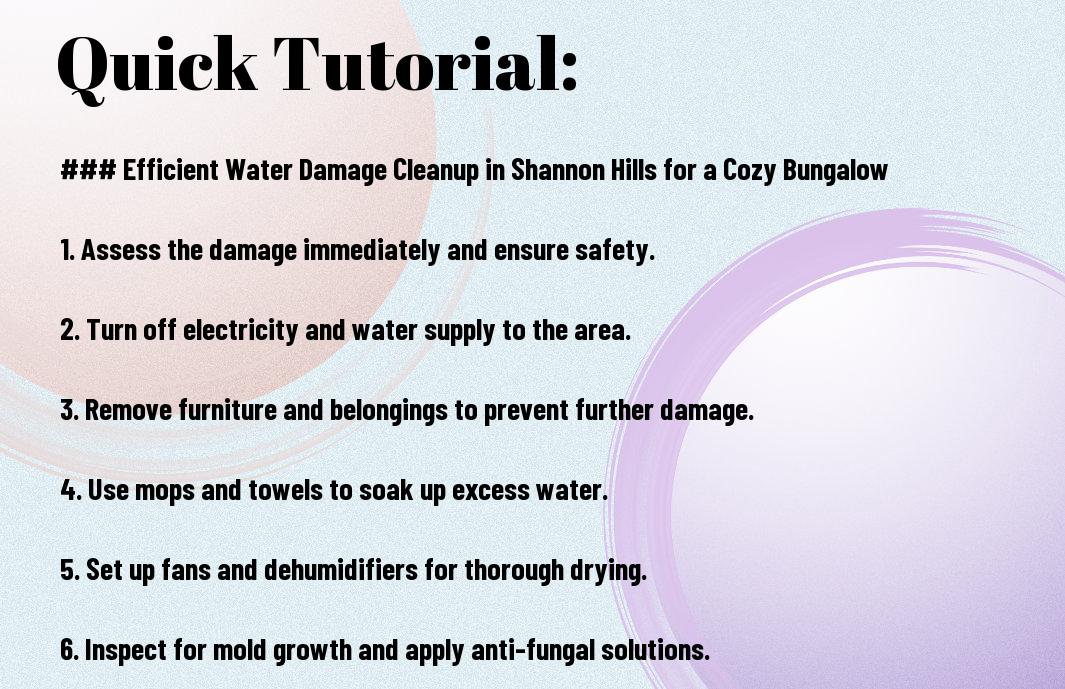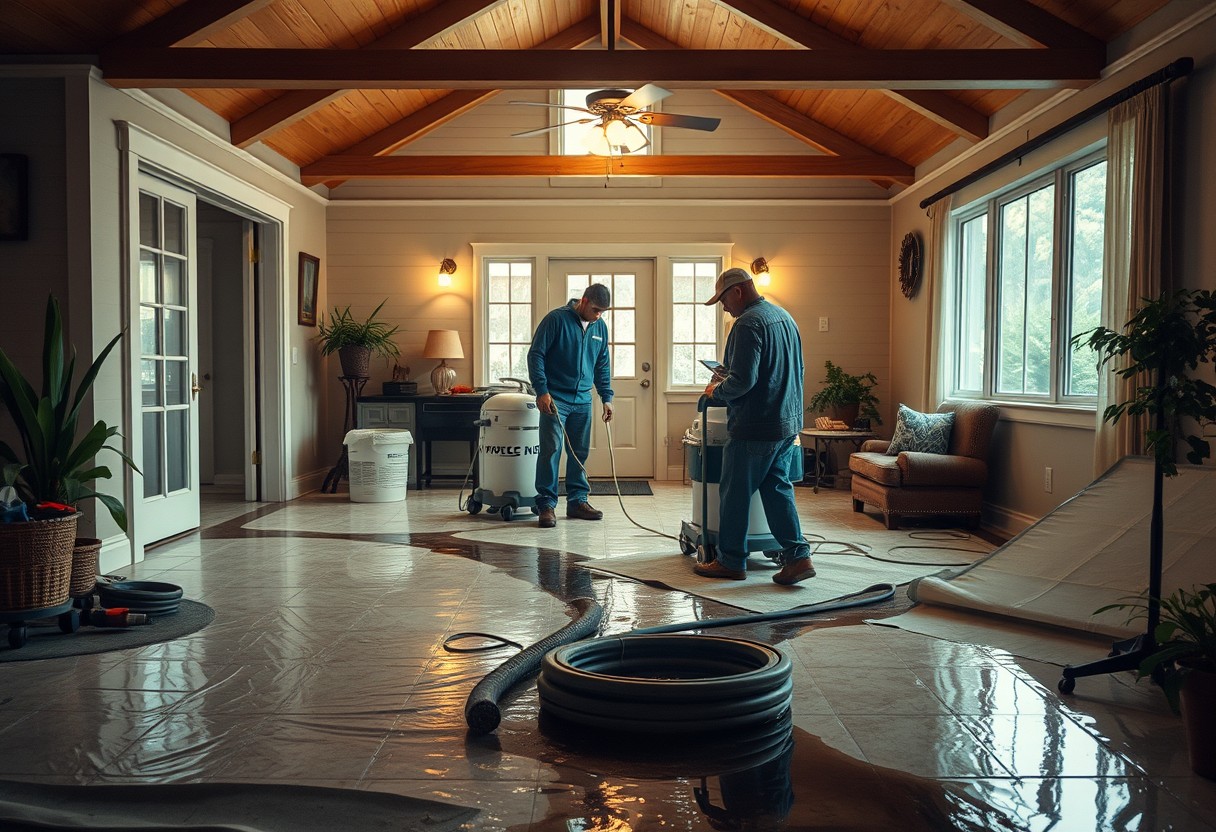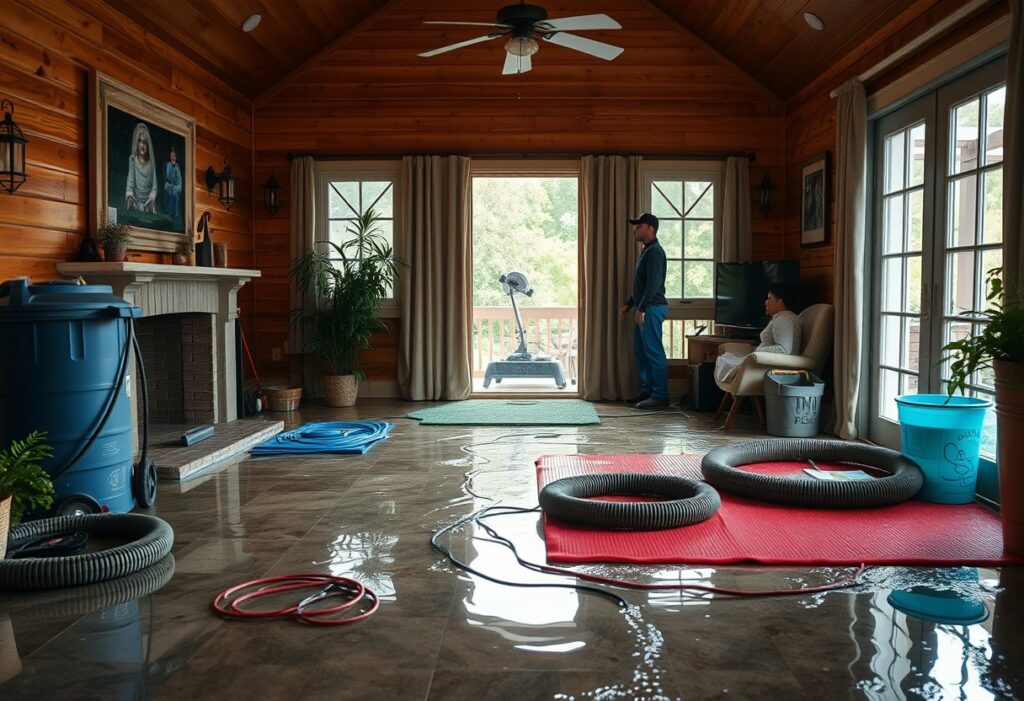Inundated with water damage? Prompt and effective cleanup is vital to restore your cozy bungalow in Shannon Hills. Understanding the process will help you tackle the situation swiftly while minimizing further harm to your property. Start by assessing the extent of the damage and ensuring your safety first. Equip yourself with the right tools and techniques to remove moisture effectively, prevent mold growth, and safeguard your home’s structure. This guide will empower you to navigate the cleanup efficiently, ensuring your sanctuary returns to its original charm.
Key Takeaways:
- Timely Response: Quickly addressing water damage is crucial in preventing further complications, such as mold growth and structural issues.
- Professional Expertise: Hiring trained specialists ensures thorough cleanup and restoration, utilizing proper techniques and equipment for effective results.
- Preventative Measures: Implementing strategies to minimize future water damage can protect your cozy bungalow, such as regular maintenance and moisture control solutions.


Understanding Water Damage
A
water damage can compromise the safety and comfort of your home, especially in a cozy bungalow. It occurs when excessive moisture infiltrates areas of your property, affecting structures, systems, and belongings. Understanding the different types of water damage – from clean water to black water – is imperative for effective cleanup and restoration. Recognizing the severity and impact can help you act swiftly to minimize long-term consequences, protecting both your health and your investment.
Common Causes of Water Damage
Damage
often occurs due to severe weather events, plumbing failures, or appliance malfunctions. Common culprits include leaky roofs, burst pipes, overflowing bathtubs, and malfunctioning washing machines. Additionally, issues with your home’s foundation or drainage system can lead to unwanted water intrusion, further exacerbating the problem. Being vigilant and conducting regular maintenance can help you stave off potential water damage before it disrupts your living environment.
Signs of Water Damage in a Bungalow
Water
damage can manifest in various ways, and knowing what to look for in your bungalow is crucial. Common indicators include visible stains on walls or ceilings, unpleasant odors, and signs of mold growth. You may also notice warping or buckling in floors and walls, as well as peeling paint. If you notice any of these warning signs, it’s imperative to address them quickly to prevent further damage and ensure a comfortable and safe living space.
Bungalow owners should be proactive in monitoring their homes for signs of water damage. Regular inspections can help you identify leaks or other issues early on. If you see discoloration on walls or ceilings, or if you detect a musty smell, it’s imperative to investigate and address the source promptly. By being vigilant about these warning signs, you protect your cozy space from more extensive and costly repairs down the line.
Immediate Action Steps
It’s crucial that you act quickly to mitigate further damage from water intrusion in your cozy bungalow. Start by prioritizing safety, securing the area, and assessing the damage before initiateing on cleanup efforts. Timely responses can significantly reduce repair costs and health risks associated with stagnant water.
Safety Precautions
Steps should be taken to ensure your safety first. Wear appropriate protective gear, such as gloves and waterproof boots. Be wary of electrical hazards—avoid using electrical appliances near water and ensure that power sources are turned off to prevent shocks or fires.
Turning Off Water Supply
Safety starts with shutting off the water supply to prevent additional flooding. Locate the main valve in your home and turn it off immediately to halt any ongoing leaks or spills.
Precautions are necessary when turning off the water supply; ensure you are aware of your home’s plumbing system layout. In case of a major leak, act fast and aim to locate the valve as quickly as possible. If you feel it is unsafe to operate the valve, don’t hesitate to contact a professional plumber for assistance.
Assessing the Damage
Clearly evaluate the extent of water damage to your belongings and structure. Look for signs of standing water, soaked materials, or warped surfaces, paying special attention to areas close to walls and floors.
Action is required here as documenting the damage is vital for insurance claims. Take photographs and note specific areas affected to create a detailed report. The sooner you assess the damage, the quicker you can initiate necessary repairs, ensuring your cozy bungalow remains a welcoming retreat.
Water Extraction Techniques
Your first step in addressing water damage in your cozy bungalow in Shannon Hills is understanding effective Worthington Hills Cleanup and Restoration methods. Utilizing the right water extraction techniques can significantly reduce the damage and help restore your home efficiently.
Using Pumps and Wet/Dry Vacuums
An vital method for water extraction involves using pumps and wet/dry vacuums. These tools help remove significant amounts of standing water quickly, minimizing the impact on your home. Ensure that you select the right pump size for the job to achieve optimal results.
Natural Drying Methods
Natural drying methods can effectively complement mechanical extraction techniques. Letting sunlight and fresh air into your home can assist in evaporating moisture after extracting the majority of the water.
Another vital aspect of natural drying is strategically placing fans and opening windows to enhance airflow. This approach can help speed up the drying process whilst preventing mold growth, which thrives in damp conditions. Ensuring adequate ventilation during this phase of water damage cleanup is crucial for maintaining a safe and healthy environment in your residence.
Professional Water Removal Services
Assuming you face extensive water damage, enlisting professional water removal services is vital. These experts possess advanced equipment and techniques to handle severe cases efficiently and ensure proper safety measures are in place.
Pumps, dehumidifiers, and specialized vacuums are standard tools used by professionals. Their experience guarantees that all affected areas are thoroughly dried and sanitized, significantly reducing the risk of future damage or health hazards such as mold. Investing in these services can save you time and provide the peace of mind that your bungalow remains a safe haven.
Cleaning and Sanitizing
After water damage occurs in your cozy bungalow, it’s vital to thoroughly clean and sanitize all affected areas to prevent long-term issues. Start by removing any standing water, followed by drying surfaces, as stagnant moisture can lead to mold growth. Use appropriate cleaning solutions to disinfect contaminated areas and ensure all debris is removed to create a safe environment for your home.
Disinfecting Affected Areas
To effectively disinfect the areas impacted by water damage, utilize a mixture of water and bleach or an EPA-approved disinfectant. Pay special attention to high-touch surfaces and materials that are particularly susceptible to contamination. This step is crucial in removing pathogens and safeguarding your family’s health.
Removing and Handling Contaminated Materials
Handling contaminated materials requires careful attention to ensure safety. First, wear protective gear, including gloves and masks, to shield yourself from harmful bacteria and spores. Remove any soaked items, such as carpeting, drywall, and furniture, as they may harbor moisture and contaminants that can pose risks to your health.
Plus, when disposing of these contaminated materials, seal them in plastic bags to prevent contamination from spreading. Follow local disposal guidelines to handle these materials responsibly. Additionally, inspect surrounding areas for hidden moisture that may require further attention to mitigate any future health hazards.
Proper Techniques for Mold Prevention
For effective mold prevention following water damage, ensure that your space is thoroughly dried within 48 hours to inhibit mold growth. Use dehumidifiers and fans to facilitate drying in hard-to-reach areas, and maintain proper ventilation in your home.
For instance, regularly inspect your home for leaks and ensure your gutters are clean to prevent overflow that can lead to moisture accumulation. Implementing good ventilation practices such as open windows and exhaust fans will also help in maintaining dry conditions, ultimately keeping your cozy bungalow mold-free.
Restoration and Repair
Keep in mind that effective restoration and repair are necessary for ensuring your cozy bungalow returns to its former glory after water damage. Engaging skilled professionals will help mitigate lingering issues and restore your home’s safety, beauty, and value.
Structural Repairs
Repairs to the structure are crucial to prevent further damage. This includes assessing foundations, walls, and any areas that may have been compromised by excessive moisture. It is vital to ensure everything is stable and secure before proceeding with other restorations.
Replacing Damaged Materials
The process of replacing damaged materials is key to preserving your home’s charm. This step often includes flooring, drywall, and insulation that cannot be salvaged due to extensive water exposure.
This ensures that your bungalow remains a safe and inviting space. Choosing high-quality replacement materials not only enhances durability but also maintains the aesthetic appeal of your home. Remember to consider environmentally friendly options if you want to lower your carbon footprint while making these necessary upgrades.
Final Touches for a Cozy Environment
Now, focus on adding the final touches that will bring warmth and comfort back into your space. This includes painting, decorating, and choosing furniture that complements your bungalow’s style.
A carefully curated selection of decor and furnishings can transform your home into a welcoming sanctuary. Incorporate soft textures, warm colors, and personal touches to create an environment that envelops you and your family in comfort after the disruption of water damage. Don’t hesitate to infuse your personality into the design, making it truly yours.
Prevention Strategies
For effective water damage cleanup in your cozy bungalow, proactive prevention strategies are important. Start by regularly inspecting your plumbing and roofing systems for leaks and wear. Additionally, consider consulting Beaverton’s #1 Water, Fire, and Mold Damage experts to bolster your home’s defenses. Implementing simple measures can save you from costly repairs down the line.
Regular Maintenance Tips
Regular maintenance of your property can greatly mitigate the risks of water damage. Here are a few important tips:
- Check and clean gutters regularly.
- Inspect and maintain plumbing fixtures.
- Seal any cracks in walls or foundations.
Assume that diligent upkeep today may protect your investment and ensure your home remains a warm and inviting space.
Installing Water Detection Systems
On top of regular maintenance, installing a reliable water detection system in your home can provide an early warning for leaks and flooding. These systems can alert you to moisture levels that exceed a predetermined threshold, allowing you to take immediate action before water damage occurs.
Plus, many water detection systems are designed to interface with smart home technology. This means you can receive real-time alerts on your smartphone, enabling you to act quickly and prevent further damage to your cozy bungalow.
Emergency Preparedness
Strategies for emergency preparedness are critical to safeguard your home against potential water damage. Have an action plan ready, which includes knowing the location of your main water shut-off valve and having a list of emergency contacts for local water damage cleanup services.
To enhance your home’s resilience, equip yourself with a well-stocked emergency kit, which should include tools like a flood barrier, towels, and a flashlight. These measures can significantly reduce your response time during unexpected flooding events and protect your home from extensive water damage.
Conclusion
Presently, efficient water damage cleanup in Shannon Hills is crucial for restoring your cozy bungalow to its former glory. By understanding key cleanup strategies and the importance of timely action, you can mitigate damage and ensure a safe, comfortable living environment. Prioritizing professional services and proper maintenance will not only streamline the recovery process but also protect your home’s value. Embrace these practices to safeguard your haven against future water-related issues.
FAQ
Q: What are the steps involved in efficient water damage cleanup for a bungalow in Shannon Hills?
A: The steps for efficient water damage cleanup typically include:
- Assessment: The first step is to assess the extent of water damage by professional inspectors. They will determine the source of the water, the areas affected, and the level of damage.
- Water Removal: Using industrial-grade pumps and vacuums, water will be removed from the affected areas. The sooner this is done, the less damage will occur, preventing issues like mold growth.
- Drying and Dehumidification: High-powered air movers and dehumidifiers will be placed in the impacted areas to thoroughly dry the space. This process can take several days to ensure that all moisture is removed.
- Cleaning and Sanitizing: After drying, the affected areas, furniture, and belongings will be cleaned and disinfected to eliminate any bacteria and odors.
- Restoration: Finally, any repairs, such as drywall replacement or floor restoration, will be completed to return your bungalow to its pre-damage condition.
Q: How can I prevent water damage in my cozy bungalow in Shannon Hills?
A: Preventing water damage involves several proactive measures, including:
- Regular Maintenance: Schedule routine inspections of your plumbing, roof, and foundation. Address any leaks, cracks, or blockages immediately.
- Install Sump Pumps: In areas vulnerable to flooding, consider installing a sump pump to remove unwanted water and reduce the risk of damage.
- Grade the Landscape: Ensure that the landscaping around your bungalow is graded away from the foundation. This helps channel rainfall away, preventing pooling near your home.
- Gutter Maintenance: Clean your gutters and downspouts regularly to ensure proper drainage. Clogged gutters can overflow and lead to water damage.
- Waterproofing: Consider waterproofing your basement and crawl spaces with appropriate coatings to further protect against moisture intrusion.
Q: What should I do if I experience water damage in my Shannon Hills bungalow?
A: If you experience water damage, you should take the following steps:
- Safety First: Ensure your safety by turning off the electricity and avoiding any contact with standing water, especially if it’s mixed with debris or unknown substances.
- Call Professionals: Contact a water damage restoration company that specializes in efficient cleanup. They have the necessary equipment and expertise to handle the situation.
- Document the Damage: Take photos of the damage for insurance claims. Document affected areas and belongings to provide a thorough report to your insurer.
- Move Valuables: If it’s safe to do so, retrieve important documents and valuables from the affected area to minimize loss.
- Stay Informed: Follow the restoration company’s guidance throughout the process and maintain communication with your insurance provider to ensure a smooth claims process.

